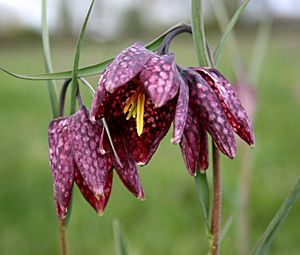Ducklington Mead facts for kids
| Site of Special Scientific Interest | |

Snake's head fritillary in Ducklington Mead
|
|
| Area of Search | Oxfordshire |
|---|---|
| Interest | Biological |
| Area | 4.6 hectares (11 acres) |
| Notification | 1986 |
| Location map | Magic Map |
Ducklington Mead is a special natural area located east of Ducklington in Oxfordshire, England. It covers about 4.6 hectares, which is roughly the size of 11 football fields! This site is officially known as a Site of Special Scientific Interest (SSSI). This means it's a protected area because it has unique plants, animals, or geological features that are very important to science and nature.
Contents
Why is Ducklington Mead Important?
Ducklington Mead is a biological SSSI. This means it's protected because of its amazing plant life. The meadow is managed in a traditional way, which helps many different kinds of plants to grow. It's like a natural treasure chest for rare and interesting species.
What Special Plants Live Here?
One of the most famous plants at Ducklington Mead is the snake's-head fritillary. This beautiful flower is quite rare and its numbers are decreasing in many places. It has a unique bell-shaped flower with a checkerboard pattern, which looks a bit like a snake's skin! Finding it here makes Ducklington Mead a very important place for nature.
Besides the snake's-head fritillary, many other interesting flowering plants thrive in the drier parts of the meadow. These include:
- Saw-wort: A plant with purple flowers that looks a bit like a thistle.
- Dropwort: A plant with creamy-white flowers that grows in clusters.
- Lady's bedstraw: A plant with tiny yellow flowers that smells sweet.
- Betony: Another plant with purple flowers, often found in grasslands.
What Else Can You Find?
The site also has ditches filled with interesting wetland plants. These plants need a lot of water to grow and are different from the ones found in the drier parts of the meadow. There's also an old hedge with many different kinds of shrubs. Hedges like this are important because they provide homes and food for many small animals and birds.
Can You Visit Ducklington Mead?
Ducklington Mead is on private land. This means it is not open to the public, so people cannot visit it. Its protected status helps make sure the rare plants and natural environment are kept safe and undisturbed.

